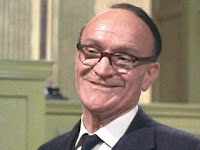Professor Stanley Unwin the comedian, who is best known for making up a language that you can understand but sounds rubbish. This in his case is the centre of his humour, rubbish that sounds funny.
In real life though, malaprops are usually delivered by people who don't even realise they are doing it. And have no idea of the difference between their condiments of the season and other fox paws.
An old friend of mine who works in a Government department, OK one of the Home Office departments, told me about a meeting the attended. The manager a bit of a straight laced humourless chap was loosing the audience.
The humourless manager stood at the lectern in an effort to bring the meeting back on track and said, "I fear our discussions are tangenital to the issues at hand."
At that my friend looked around at the other attendees who were all fighting back laughter. She had to excuse herself from the meeting to keep from laughing out loud, a career halter in the Civil Service.
The humourless manager stood at the lectern in an effort to bring the meeting back on track and said, "I fear our discussions are tangenital to the issues at hand."
At that my friend looked around at the other attendees who were all fighting back laughter. She had to excuse herself from the meeting to keep from laughing out loud, a career halter in the Civil Service.
A flexible presenter who was truly in touch would have
1) Realised their mistake quickly,
2) Laughed at themselves, and
3) Used that unplanned comic relief to get everyone's attention so that she could regain control of the meeting.
Someone really experienced would make the mistake on purpose.
Over the years of writing speeches I’ve learned, that many times the mistakes are much funnier than the planned presentation. These days I plan mistakes when appropriate. This has a great affect on your audience frequently opening up the presentation.
Over the years of writing speeches I’ve learned, that many times the mistakes are much funnier than the planned presentation. These days I plan mistakes when appropriate. This has a great affect on your audience frequently opening up the presentation.
The next time you experience a tangential experience use it to your advantage. Relax your audience, smooth your way through the situation and you will have delivered a more memorable presentation. Well Done.
If you’d like to improve your public speaking and presentation skills – get in touch! Feel free to comment if this tip has helped you, share your own ideas or ask a public speaking question Paul will try to help!
and
Paul M Johnstone
Catch up with you again soon!
Paul Johnstone is the founder of
The Paradigm Shakers
Providers of Thought Provoking Training
Delivered by Subject Matter Experts
©Paul Johnstone 


